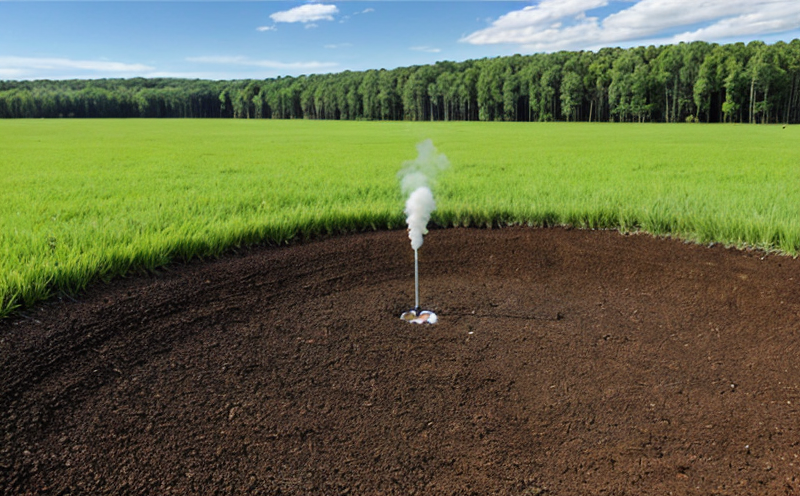EPA 300.1 Inorganic Anions in Mining Waters Testing
The EPA 300.1 method is a critical tool used to assess the environmental impact of mining operations on water quality, specifically targeting the presence and concentration of inorganic anions commonly found in mining waters. This testing protocol is essential for regulatory compliance and ensuring that mining activities do not degrade water bodies adversely.
Inorganic anions are compounds that can have significant impacts on aquatic ecosystems and human health. Common anions tested include chloride, nitrate, fluoride, bromide, iodide, phosphate, sulfate, and arsenate. The presence of these anions can lead to increased salinity, toxicity, or other detrimental effects on water quality.
The method is based on the collection and analysis of water samples from mining sites using ion chromatography techniques. This involves dissolving the sample in a suitable solvent and then passing it through an ion-exchange column to separate different ions. The separated ions are detected by their electrical conductivity, allowing for quantification.
Sampling protocols must follow strict guidelines to ensure accurate results. This includes selecting appropriate sampling points, ensuring proper storage and transport of samples, and minimizing contamination during the collection process. Compliance officers need to be aware that deviations from these protocols can lead to inaccurate test results and potential regulatory issues.
The importance of this testing cannot be overstated for several reasons:
- To ensure compliance with environmental regulations such as the Clean Water Act (CWA).
- To monitor changes in water quality over time, providing valuable data for long-term studies.
- To inform decision-making processes related to pollution control and mitigation strategies.
Understanding the results of this test is crucial for mining companies to manage their environmental impacts effectively. The data can be used to implement corrective actions or justify existing practices to regulatory bodies. For quality managers, this testing serves as a benchmark against which improvements in water quality can be measured. R&D engineers can use these findings to develop new technologies aimed at reducing the impact of mining activities on local ecosystems.
In conclusion, EPA 300.1 is not just a compliance requirement; it's an integral part of responsible mining practices that contribute positively to environmental sustainability.
Why It Matters
The results of the EPA 300.1 test are crucial for understanding and managing the environmental impact of mining operations on water quality. By identifying and quantifying inorganic anions, this testing helps ensure that mining activities comply with local, state, and federal regulations.
Water is a precious resource that supports life both above and below ground. Mining activities can introduce harmful substances into surface and groundwater supplies, affecting not only the immediate environment but also downstream ecosystems. The presence of high levels of certain anions, such as chloride or nitrate, can lead to increased salinity, which can harm aquatic flora and fauna.
Moreover, these tests help in assessing the effectiveness of pollution control measures implemented by mining companies. By regularly monitoring water quality before and after treatment processes, companies can evaluate whether their efforts are yielding positive results. This continuous assessment is vital for maintaining compliance with environmental standards and protecting public health.
For example, if a mine has been treating its wastewater to reduce chloride levels, the EPA 300.1 test can provide evidence of success or highlight areas where further improvements are needed. Similarly, inorganic anions like fluoride and arsenate can pose serious risks to human health through contaminated drinking water. Ensuring these are kept within safe limits is crucial for safeguarding public well-being.
The data from this testing also supports broader sustainability goals by providing insights into the overall impact of mining operations on local ecosystems. This information can be used to develop more sustainable practices that minimize harm while maximizing benefits. Compliance officers play a vital role in ensuring that all relevant tests are conducted regularly and accurately, allowing for proactive management of potential issues.
Scope and Methodology
The scope of EPA 300.1 testing encompasses the identification and quantification of specific inorganic anions present in mining waters. The primary focus is on ensuring that these waters meet regulatory standards set by environmental protection agencies.
The methodology involves several key steps:
- Sampling: Samples are collected from various points within the mine site, including effluents and tailings ponds. Proper sampling techniques are crucial to avoid contamination and ensure accurate results.
- Solution Preparation: Collected samples undergo dissolution procedures before being analyzed using ion chromatography.
- Analysis: The dissolved sample is passed through an ion-exchange column where different ions are separated based on their electrical conductivity. Detection occurs via conductivity measurements, providing precise quantification of each anion present.
- Data Interpretation: Results from the analysis are interpreted in terms of compliance with established limits for each target anion.
Sampling protocols must strictly adhere to regulatory guidelines to ensure accurate representation of water quality. Compliance officers should familiarize themselves with these guidelines, as non-compliance can lead to invalid test results and potential legal consequences.
The use of ion chromatography ensures high precision and accuracy in detecting even low concentrations of anions. This advanced analytical technique allows for the simultaneous identification and quantification of multiple compounds, making it ideal for comprehensive environmental assessments.
Environmental and Sustainability Contributions
- Water Quality Improvement: By identifying and addressing issues related to inorganic anions, EPA 300.1 testing helps mitigate pollution risks, leading to cleaner water supplies.
- Biodiversity Protection: Ensuring that aquatic ecosystems remain healthy supports biodiversity by preventing harmful substances from entering food chains.
- Public Health Safeguarding: Reducing levels of toxic anions like arsenate and fluoride in drinking water protects public health.
- Sustainable Practice Promotion: Encouraging continuous monitoring fosters a culture of sustainability within mining operations, promoting long-term environmental stewardship.
These contributions are essential for achieving sustainable development goals that balance economic growth with environmental protection. Mining companies can contribute positively to society by adhering to rigorous testing protocols like EPA 300.1 and using the resulting data to implement effective pollution control measures.





